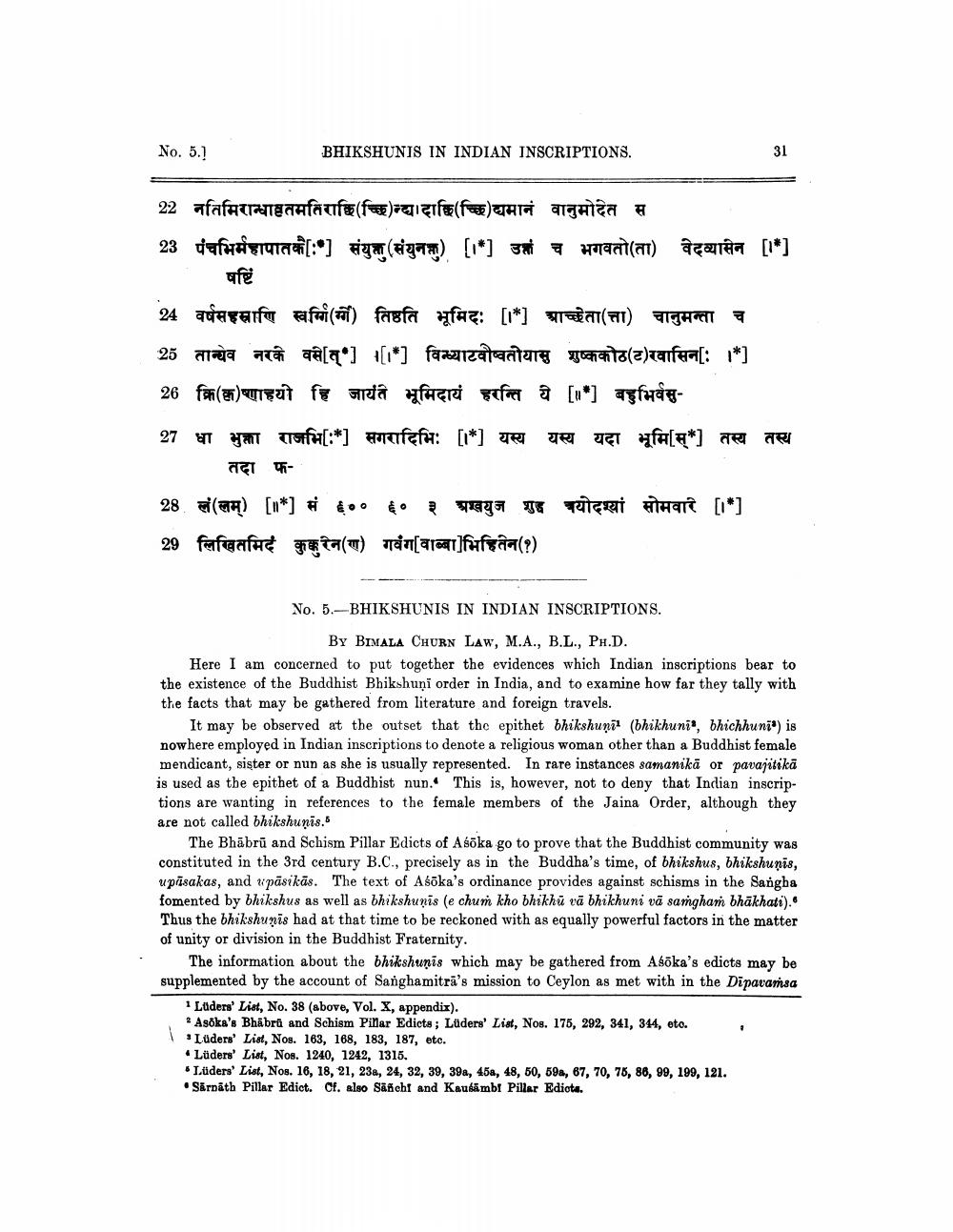________________
No. 5.]
BHIKSHUNIS IN INDIAN INSCRIPTIONS.
22 नतिमिरान्धाष्टतमति राशि (च्छिन्द्या दाछि (च्छि ) द्यमानं वानुमोदेत स
23 पंचभिर्महापातके[:] संयुक्त (संयुक्त) [1] उ च भगवतो (ता) वेदव्यासेन [*] षष्टिं
24 वर्षururu (माँ) तिष्ठति भूमिदः [1"] चाच्छेता (त्ता) चानुमन्ता च
25 तान्येव नरके वसे [त्*] [1*] विन्ध्याटवीष्वतीयासु शुष्ककोठ(ट) रवासिन [: । *] 28 क्रिया हि जायंत भूमिदायं हरन्ति ये [n] बहुभिर्वसु
27 धा भुक्ता राजभि[:*] सगरादिभिः [*] यस्य यस्य यदा भूमिम् *] तस्य तस्य तदा फ
28 लं (लम्) [॥*] सं ६००
29 लिखितमिदं कुकुरेन (ग)
६० ३ अश्वयुज शुद्ध त्रयोदश्यां सोमवार [*] गर्वग[ वाल्या ]भिहितेन (?)
31
No. 5. – BHIKSHUNIS IN INDIAN INSCRIPTIONS.
BY BIMALA CHURN LAW, M.A., B.L., PH.D.
Here I am concerned to put together the evidences which Indian inscriptions bear to the existence of the Buddhist Bhikshuni order in India, and to examine how far they tally with the facts that may be gathered from literature and foreign travels.
It may be observed at the outset that the epithet bhikshuni1 (bhikhuni, bhichhuni") is nowhere employed in Indian inscriptions to denote a religious woman other than a Buddhist female mendicant, sister or nun as she is usually represented. In rare instances samanikä or pavajitikā is used as the epithet of a Buddhist nun. This is, however, not to deny that Indian inscriptions are wanting in references to the female members of the Jaina Order, although they are not called bhikshunis."
The Bhābru and Schism Pillar Edicts of Asōka go to prove that the Buddhist community was constituted in the 3rd century B.C., precisely as in the Buddha's time, of bhikshus, bhikshunis, upāsakas, and upāsikās. The text of Aśoka's ordinance provides against schisms in the Sangha fomented by bhikshus as well as bhikshunis (e chum kho bhikhu vā bhikhuni vā saṁgham bhākhati). Thus the bhikshunis had at that time to be reckoned with as equally powerful factors in the matter of unity or division in the Buddhist Fraternity.
The information about the bhikshunis which may be gathered from Asōka's edicts may be supplemented by the account of Sanghamitra's mission to Ceylon as met with in the Dipavamsa
1 Lüders' List, No. 38 (above, Vol. X, appendix).
2 Asoka's Bhabra and Schism Pilar Edicts; Luders' List, Nos. 175, 292, 341, 344, etc.
Lüders' List, Nos. 163, 168, 183, 187, etc.
• Lüders' List, Nos. 1240, 1242, 1315.
Lüders' List, Nos. 16, 18, 21, 23a, 24, 32, 39, 39a, 45a, 48, 50, 59a, 67, 70, 75, 86, 99, 199, 121.
• Sārnath Pillar Edict. Cf. also Ssicht and Kausambt Pillar Ediota.




